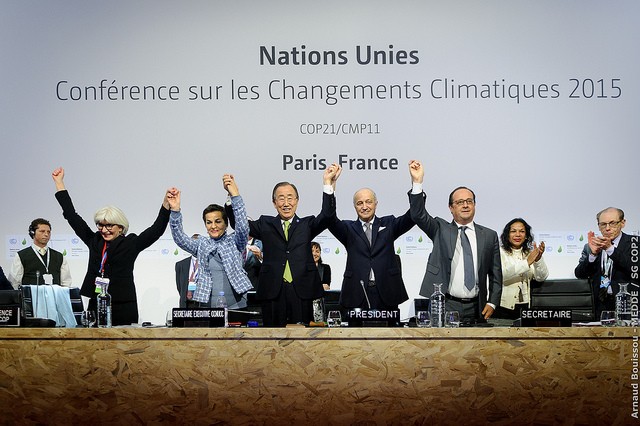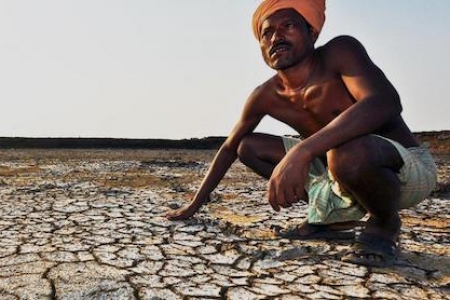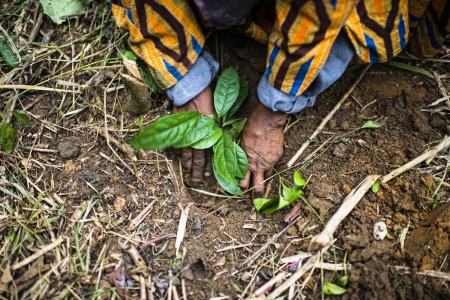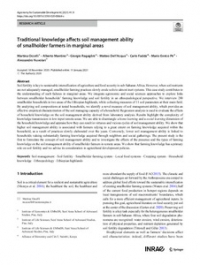Carbon in landscapes
Climate change activists were cock-a-hoop at the conclusion of the Paris Agreement last weekend. Green-energy advocates had big smiles on their faces. But what about those wanting an agreement that would restore and sustainably manage landscapes? What did the deal say about forests and forest dwellers? Did it give a boost to “climate-smart agriculture”? Or do we just face a blitz of low-carbon hydroelectric dams?
The big story must be that the target to keep warming “well below two degrees Celsius” is a boost for the stability of ecosystems and the protection of people who rely on them. The pledge to “pursue efforts” to keep warming to 1.5 degrees sounds even better.

It’s not all good news
There is a danger, however. IPCC scientists warn that a temperature ceiling of 1.5 degrees in particular can only be achieved through widespread deployment of negative-emissions technologies. These would likely include turning over large amounts of land to fast-growing monocultures of carbon-sink forests and biomass crops that would be burned in power stations fitted with technology to capture and bury carbon emissions.
None of which sounds like good news for food security, smallholder farmers, the land rights of rural communities or efforts to encourage an ecosystem-based approach to managing agricultural landscapes.
But the agreement itself barely touches on these issues. It makes no direct mention of agriculture, landscapes or land use at all. And it is light even on references to forests, stressing merely the need for reducing emissions from deforestation and forest degradation, and “the role of conservation, sustainable management of forests and enhancement of forest carbon stocks” in fighting climate change.
It mentions “the rights of indigenous peoples [and] local communities”, though not specifically to land or forests. And it calls for the establishment of a “platform” for them to share “best practices on mitigation and adaptation” to climate change “in a holistic and integrated manner”.
The question now is how these vaguely defined priorities will play out within countries. The first point of reference is the emissions pledges, known as Intended Nationally-Determined Contributions (INDCs), submitted by almost all countries to the conference. Forest sinks are identified as a route to reducing emissions in more than 40 of these national pledges, though usually without reference to landscapes or land use.
Some point in the direction of turning forests into carbon farms. Thus Russia promises that “our strategy is for more intense forest management which can increase both carbon sequestration and timber production.” But, more hopefully, many will see Brazil is an example of what can be achieved.
Brazil is the only major developing country to pledge to reduce its emissions between now and 2030 (as opposed to the usual option of reducing the carbon intensity of their economies or shaving emissions below business-as-usual). It pledged to cut its emissions by 40 percent between 2005 and 2030. Most remarkably, this target has been almost achieved already, thanks to an 80 percent reduction in deforestation rates in the Amazon basin in the past decade.
Brazil’s president Dilma Rousseff plans to offset rising emissions from fossil-fuel burning with further curbs on deforestation and, as she told the opening session in Paris, by “restoring and reforesting 12 million hectares of forests and another 15 million hectares of degraded pasture land.”
Neighbouring Peru may need to adopt a similar approach. It has promised to cut emissions from 20 to 30 percent below business as usual. But to achieve that will almost certainly require a drastic cut in deforestation. There is little doubt that the Peruvian environment minister Manuel Pulgar-Vidal, who played a prominent role in Paris, would like to do that. But in the past two years other ministries in his government have been passing laws that restrict his ministry’s powers to protect forests against land grabs by palm-oil companies.
Other nations whose emissions are dominated by forests and land use face similar questions. Indonesia pledged to reduce greenhouse-gas emissions by up to 41 percent from business as usual. But it nowhere makes clear what business as usual means, particularly for its forests and peatlands, whose degradation are responsible for some 60 percent of the country’s emissions in a typical year.
In such countries, meeting targets will depend crucially on how much of the large amounts of climate-finance promised under the agreement is devoted to bolstering landscapes as carbon sinks.
Money is on the table for landscape projects
It is not yet clear what priority will be given to landscapes by the two UN-designated routes for channelling the promised $100 billion a year of climate funds from 2020, the Green Climate Fund and the Global Environment Facility. Discussion about finance in Paris centred mostly on what proportion of the money should go on bringing low-carbon energy technologies to developing countries, and what proportion on helping those countries adapt to climate change.
The good news about landscape investment is that, properly done, it can achieve both – soaking up carbon while at the same time providing ecological buffers against, floods, droughts, storms and other extreme weather. And in side-events during the two weeks of negotiations, donors did put money on the table for landscape projects.
Norway, Germany and the UK for instance, promised a billion dollars a year in “pay for performance” finance for forest protection. Norway separately announced $150 million for forest protection in Liberia and a $100 million fund for conservation work by indigenous forest peoples.
Perhaps the biggest new initiative was for a grand restoration of 100 million hectares of degraded African landscapes, an area three times the size of Germany, by 2030. “We need landscape restoration for development and for climate,” said Ngozi Okonjo-Iweala, a former Nigerian finance minister, who helped launch the “afr100” project at the Global Landscape Forum in Paris. An estimated $2 billion a year will be channelled though the World Bank, the African Union’s New Partnership for Africa’s Development (NEPAD) and others.
Meanwhile, $4 billion from the World Bank and the French government was put on the table for the Great Green Wall, aimed at reviving landscapes to hold back the Sahara desert.
Land restoration – through the goal of achieving a “land-degradation neutral world” – was recently adopted in the Sustainable Development Goals and is now attracting attention as a means of mitigating and adapting to climate change, while stimulating development and environmental resilience. It ticks many boxes. Launching the African initiative, Andrew Steer, CEO of another partner, the World Resources Institute, declared that “carbon will come back to earth in trees, bushes, crops and soils, where it will bring life and prosperity.”
For many developing countries, carbon in landscapes looks like a key ingredient as they try to live up to their pledges made in Paris over the next 15 years.













Comments
Hi Fred, do you Think a small country like Haiti could receive some of that " land restoration money"? I'm from there! We don't emit that much CO2 but our land is completely degraded. If yes, what would be the channels ? How to apply? Thanks.